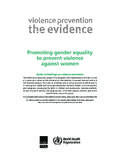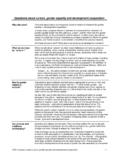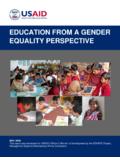Transcription of EFFECTIVE STRATEGIES FOR PROMOTING GENDER …
1 EFFECTIVE STRATEGIES FOR PROMOTING GENDER equality . How can we increase the likelihood of women benefiting equally from development activities? What STRATEGIES have proven to be EFFECTIVE in the field? This tipsheet summarises STRATEGIES which have worked in practice, based on findings from a review Involve stakeholders from civil society in of 85 evaluations undertaken by bilateral and dialogue on objectives and activities. National multilateral agencies from 1999 to 2002. There was machineries for women, local women's a great deal of consistency in evaluation reports organisations, NGOs and other local advocates about the most EFFECTIVE STRATEGIES for addressing for women's rights can play a key role in GENDER equality issues, regardless of the type of setting directions for country STRATEGIES and in assistance, the donor agency, the partner country or activity design.
2 They can hold institutions sector. Findings from the review also support accountable for addressing gaps between anecdotal evidence about how to promote GENDER commitments and practice. equality in development programming. Make long-term commitments to partners and Discuss GENDER equality with partner countries activities. This is essential for sustainable progress towards GENDER equality at both macro Dialogue to develop partnerships on GENDER equality and micro levels. is needed when agencies are developing country assistance STRATEGIES , and also at the activity level Assess and strengthen partner capacity for during design and implementation.
3 This means that GENDER responsive and participatory analysis, development workers need to talk with partners planning and implementation. Lack of about how women's needs, benefits and rights are attention to partner capacity is a major obstacle relevant to the development activities being planned to addressing GENDER equality issues. Assessing and implemented, taking into account the social, partner commitment, capacity and context economic and political context; and how equal provides insight into the types of interventions benefits will increase the effectiveness of activities on GENDER equality which may be successful, and the sustainability of outcomes.
4 Ideally, this and helps to identify appropriate STRATEGIES for dialogue and negotiation will result in agreement on strengthening partner capacity. For example, in investments and activities, with a clear difficult social contexts, the use of sound data understanding of how benefits for both women and based on empirical research and evaluation can men will be realised. help to make a case for investing in women, and for strengthening partner capacity. Knowing Successful partnerships had: and understanding the partner is essential for a shared vision EFFECTIVE dialogue, and for negotiating shared stakeholder involvement objectives.
5 Long-term commitments attention to partner capacity Prepared for the OECD DAC Network on GENDER Develop a shared vision and explicit consensus equality by Juliet Hunt, April 2004. Based on on GENDER equality objectives relevant to the Juliet Hunt and Ria Brouwers 2003 Review on country strategy or development activity. GENDER and Evaluation: Report to DAC Working Evaluations show that lack of ownership of Party on Evaluation undertaken by AusAID and GENDER equality goals and STRATEGIES is a key the Netherlands' Ministry of Foreign Affairs obstacle to addressing GENDER issues in development activities.
6 Ownership of objectives and approaches is more likely to be shared if there is a clear link to policies and commitments that the partner has already made on equality for women. 1. EFFECTIVE STRATEGIES for activity design, baseline information and for employing implementation and monitoring participatory approaches. There is very clear evidence that attention to GENDER Ensure that GENDER STRATEGIES are practical, issues in activity design and implementation is and based on quality GENDER analysis. GENDER essential if agencies want to increase the likelihood STRATEGIES need to identify how differences that both women and men will participate and between women and men are relevant in each benefit, and to ensure that they are not programme and context, and what this means disadvantaged by development activities.
7 Even very for the way the programme is designed and limited attention to GENDER issues in design can implemented: what activities are needed, with make a significant difference to whether women whom and why; what results are expected; how benefit, although local context is critical for these activities and results contribute to sustaining benefits and for making progress towards achieving the overall objectives of the GENDER equality . intervention; resources needed; and indicators to monitor the strategy and its results. To ensure that they are implemented, key elements of Social, institutional and political context is GENDER STRATEGIES need to be integrated into critical for sustainability of benefits day-to-day implementation and management Some macro-level evaluations found that the local tools and processes, such as the logical cultural, institutional and policy context is more framework matrix.
8 Important than activity design in determining whether Provide in-country social and GENDER analysis women will benefit, and whether benefits will be expertise to undertake analysis and support the sustained. For example, both women and men benefited from largely GENDER blind World Bank implementation and review of all STRATEGIES . assistance in Poland and Vietnam, where Ensure that responsibilities for implementing implementing partners stepped in to effectively target GENDER equality objectives are explicit in job women, or where women were able to access benefits.
9 Descriptions, Scopes of Services and Terms of DFID found that including GENDER equity in design had Reference, for all personnel at every stage little impact in public health systems, unless partner through the activity cycle. This significantly government policies and practices were increases the likelihood that GENDER equality issues will be seriously addressed, as long as Incorporate GENDER equality objectives into there are sufficient resources, time and support activity, programme or project objectives. This available to develop and monitor GENDER is often noted as a key reason for success when equality STRATEGIES .
10 Having staff and evaluators find positive benefits and impacts for stakeholders who are competent and committed women. This does not mean that activities need to GENDER equality is also a critical success to focus exclusively on women or on achieving factor. The review found that training is most equality . GENDER equality issues are given more EFFECTIVE at increasing competence, and more systematic and serious attention if they are likely to be applied, when it is sector-specific reflected in the design objectives. This and directly linked to individual project increases the likelihood that attention to GENDER contexts and activities.













